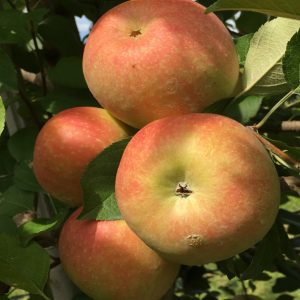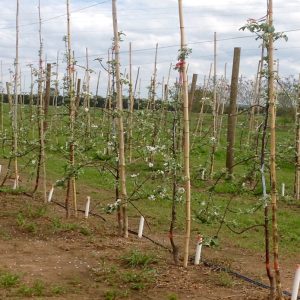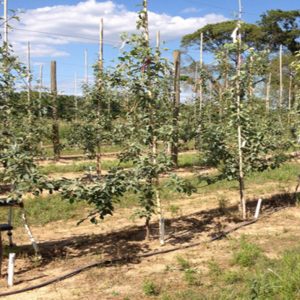Crop Production

The tall spindle trellis system is one of the newer training and trellising technologies that utilizes high-density apple plantings for early production of high-quality fruit (figure 1). This system has shown to be the best trellis system that provides early returns to producers and has been successfully utilized in new plantings.
This system relies on utilizing well-feathered trees (ones with branches) that can produce a crop the year after planting and can continue to increase fruiting in the immediate subsequent years. The tall spindle trellis system was developed as an offshoot of the slender spindle training system to take advantage of increased canopy volume by increasing tree height.
Components
There are several important components needed to develop a tall spindle training system:
- High-density plantings (800 to 1,500 trees per acre).
- Fully dwarfing rootstocks.
- Nursery trees that have ten to fifteen feathers (branches).
- Minimal pruning at planting.
- Feathers that are bent (tied) below horizontal immediately after planting (figure 2).
- The absence of permanent scaffold branches.
- Renewed branches as they get too large.
- Figure 1. Fruit of ‘Aztec Fuji’ trees trained to a tall spindle trellis system at the Chilton Regional Research and Extension Center in Clanton, Alabama.
- Figure 2. Tall spindle trained apple trees with their feathers bent below horizontal during the second growing season.
- Figure 3. During the third growing season, secure the leader to the support trellis.
Training
Successfully training apple trees to a tall spindle trellis system starts with planting. Plant trees that have ten to fifteen feathers at a spacing of 3 to 4 feet by 11 to 12 feet. Adjust the graft union to 4 to 6 inches above the soil level.
Then, remove all feathers that are growing below 24 inches on the trunk by using a flush cut. Do not head the leader or the feathers. Remove any feathers that are larger than two-thirds the diameter of the leader at the point of insertion. When the branches are 3 to 4 inches long, rub off the second and third shoots below the new leader shoot to eliminate competitors.
Install a three-wire trellis support system to support the tree up to 10 feet tall. Attach the trees to the support system by using a permanent tree tie above the first tier of feathers, leaving a 2-inch-diameter loop to allow for trunk growth. Tie down each feather that is longer than 10 inches to a pendant position below horizontal.
During the first dormant season (second growing season), do not head the leader or prune branches unless there are scaffolds that are more than half the diameter of the central axis. When branches reach 4 to 6 inches of growth, pinch the lateral shoots in the top fourth of last year’s leader growth, removing about 2 inches of growth. This includes the terminal bud and four to five young leaves. Tie the developing leader to the support system with a permanent tie.
Vigorous branches that grew more than two-thirds the diameter of the leader should be removed using a bevel cut during the second dormant season. Use a permanent tie to secure the developing leader to the support trellis (figure 3). In late summer, apply summer pruning to promote light interception and improve fruit color development.
Continue to remove overly vigorous limbs that are more than two-thirds the diameter of the leader by using a bevel cut during the fourth growing season. Do not head the leader. Tie the developing leader to the support system with a permanent tie at the top of the wire and lightly summer prune to encourage good light penetration and fruit color in late summer.
For an established and mature apple tree (fifth growing season and beyond), cut the leader back to a fruitful side branch to limit the tree height. Annually, start removing at least two limbs, including the lower-tier scaffolds that are more than two-thirds the diameter of the leader, by using a bevel cut. Columnize the branches by removing any side branches that develop. Remove any limbs larger than 1 inch in diameter in the upper 2 feet of the tree.




